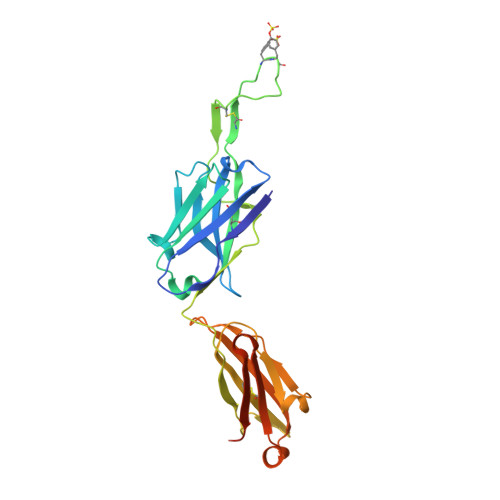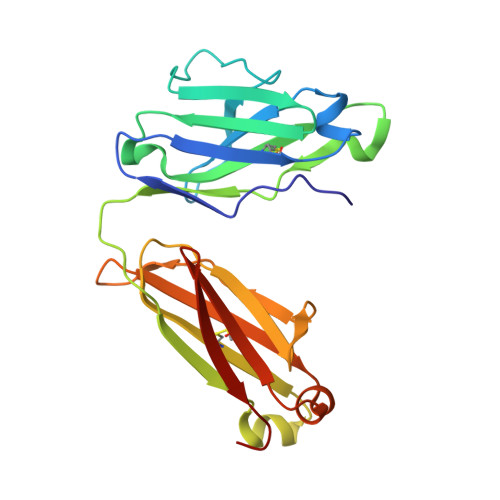New Member of the V1V2-Directed CAP256-VRC26 Lineage That Shows Increased Breadth and Exceptional Potency.
Doria-Rose, N.A., Bhiman, J.N., Roark, R.S., Schramm, C.A., Gorman, J., Chuang, G.Y., Pancera, M., Cale, E.M., Ernandes, M.J., Louder, M.K., Asokan, M., Bailer, R.T., Druz, A., Fraschilla, I.R., Garrett, N.J., Jarosinski, M., Lynch, R.M., McKee, K., O'Dell, S., Pegu, A., Schmidt, S.D., Staupe, R.P., Sutton, M.S., Wang, K., Wibmer, C.K., Haynes, B.F., Abdool-Karim, S., Shapiro, L., Kwong, P.D., Moore, P.L., Morris, L., Mascola, J.R.(2015) J Virol 90: 76-91
- PubMed: 26468542
- DOI: https://doi.org/10.1128/JVI.01791-15
- Primary Citation of Related Structures:
5DT1 - PubMed Abstract:
The epitopes defined by HIV-1 broadly neutralizing antibodies (bNAbs) are valuable templates for vaccine design, and studies of the immunological development of these antibodies are providing insights for vaccination strategies. In addition, the most potent and broadly reactive of these bNAbs have potential for clinical use. We previously described a family of 12 V1V2-directed neutralizing antibodies, CAP256-VRC26, isolated from an HIV-1 clade C-infected donor at years 1, 2, and 4 of infection (N. A. Doria-Rose et al., Nature 509:55-62, 2014, http://dx.doi.org/10.1038/nature13036). Here, we report on the isolation and characterization of new members of the family mostly obtained at time points of peak serum neutralization breadth and potency. Thirteen antibodies were isolated from B cell culture, and eight were isolated using trimeric envelope probes for differential single B cell sorting. One of the new antibodies displayed a 10-fold greater neutralization potency than previously published lineage members. This antibody, CAP256-VRC26.25, neutralized 57% of diverse clade viral isolates and 70% of clade C isolates with remarkable potency. Among the viruses neutralized, the median 50% inhibitory concentration was 0.001 μg/ml. All 33 lineage members targeted a quaternary epitope focused on V2. While all known bNAbs targeting the V1V2 region interact with the N160 glycan, the CAP256-VRC26 antibodies showed an inverse correlation of neutralization potency with dependence on this glycan. Overall, our results highlight the ongoing evolution within a single antibody lineage and describe more potent and broadly neutralizing members with potential clinical utility, particularly in areas where clade C is prevalent. Studies of HIV-1 broadly neutralizing antibodies (bNAbs) provide valuable information for vaccine design, and the most potent and broadly reactive of these bNAbs have potential for clinical use. We previously described a family of V1V2-directed neutralizing antibodies from an HIV-1 clade C-infected donor. Here, we report on the isolation and characterization of new members of the family mostly obtained at time points of peak serum neutralization breadth and potency. One of the new antibodies, CAP256-VRC26.25, displayed a 10-fold greater neutralization potency than previously described lineage members. It neutralized 57% of diverse clade viral isolates and 70% of clade C isolates with remarkable potency: the median 50% inhibitory concentration was 0.001 μg/ml. Our results highlight the ongoing evolution within a single antibody lineage and describe more potent and broadly neutralizing members with potential clinical utility, particularly in areas where clade C is prevalent.
Organizational Affiliation:
Vaccine Research Center, National Institute of Allergy and Infectious Diseases, National Institutes of Health, Bethesda, Maryland, USA.

















